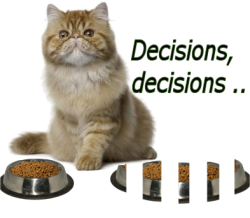More (but smaller) meals may help obesity in cats.

As we have discussed before (see our article on obesity ), feline obesity is most often the result of the cat eating too much. The old idea that a cat will only eat as much as she needs is simply not true, especially in an age of nutrient-dense and highly-attractive cat foods. Certainly a cat will eat as much as she needs, but she probably won't stop there. Quite often obesity is a product of simple boredom, especially for indoor cats. Left alone with not much to do while their humans are at work, these cats will eat more than they need as a way of killing time.
As with humans, weight-loss diets often don't work with cats. But - again as with humans - research (ref) suggests that, with cats, calories burned by increased exercise are better than calories simply left off the plate or food bowl. And in the end it all goes back to how much exercise your cat does relative to the food she consumes. And increasing the amount of exercise may be simpler than you think. By increasing the frequency of meals without adding to or cutting the overall amount of calories per day your cat will become more active and therefore more likely to maintain a healthy weight..
This theory was recently tested by animal sciences researcher Kelly Swanson and his colleagues at the University of Illinois in a two-part study. This study featured ten adult neutered male cats, all of whom started out as being reasonably lean. For the first part of the test, the cats were divided into four groups. All groups were given the same amount of food, but the frequency of mealtimes was different.
The first group of cats received four meals a day; the second group received two meals daily and cats in the third group were given a single mega-meal per day. The fourth and final group had no idea what they were getting, because though the amount of calories offered remained the same, these calories came in a random number of mealtimes. The cats were given two weeks to adjust to their new diet and then from days 15 through 22, each catís daily exercise was measured by an activity collar which recorded their movements.
The study showed that the cats were most active in the time just before they expected to be fed. This is called 'FAA' by animal behaviourists - food anticipatory activity. Itís why your cat jumps on to the table while you are preparing the food, or climbs up your leg while you are holding it, even though the cat knows very well that the food will shortly be set down for her to eat. Just the thought of getting fed makes the cat more active. This activity was particularly visible in cats which received four meals a day and those given meals at random times. Basically, cats which received more than two meals a day were more active cats.
Interestingly, cats which ate just once a day seemed more active when it was dark, while cats which ate more often were busier in daylight hours. So you may like to experiment for yourself to see if there is a correlation between feeding the cat one large meal when you get home from work and the cat later driving you nuts by racing around the flat after midnight.
The scientists then tried a second test to see if an increase in the water content of a diet made the cats feel more or less active. The same group of cats was 'volunteered' and this test came right after the first, taking up days 22 to 27. This time the cats were separated into two groups. One group of cats received dry cat food and the second group received the same amount of food but with added water. This time around, the increased activity came not in food anticipatory activity but after the cats had eaten - and it was the 'wet food' group that was most active. The researchers admit they are not completely sure why this was so, but more water in means more water out, so increased use of the litter box might have been a factor.
The four-week study showed some clear conclusions. Cats which received extra water and more frequent meals were more active, and burned significantly more calories than cats which ate less frequently and took in less water with each meal. So if you are the abashed owner of an obese cat, it is well worth discussing with the vet not only how much food the cat should eat, but also how often she should eat it. And food with a higher water content means a busier cat than a dry-food kitty. Nor is this study a definitive solution. A cat that has lots to interest her, who plays often with her human and has plentiful opportunities to exercise will still be fitter than a cat that remains alone and bored, no matter what the variations in diet.
As Dr Swanson points out 'It all comes down to energy in and energy out. It's very simple on paper, but it's not that easy in real life, especially in a household where there is more than one pet. That can be difficult, but I think these two strategies are very practical ideas that people can use.'
Journal Reference:
P. Deng, E. Iwazaki, S. A. Suchy, M. R. Pallotto, K. S. Swanson. Effects of feeding frequency and dietary water content on voluntary physical activity in healthy adult cats. Journal of Animal Science (2014) http://www.journalofanimalscience.org/content/92/3/1271
The information supplied here is intended as a guideline only.
